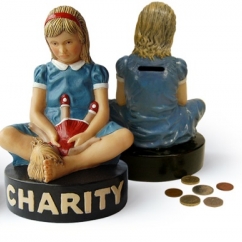Articles and News
CHARITABLE GIVING: IS IT BETTER TO GO LOCAL OR GLOBAL? November 02, 2011 (0 comments)

London, United Kingdom—More than half of the world’s wealthy consumers feel a responsibility to give to those less fortunate, according to findings presented at the Luxury Briefing Wealth Summit held here recently and reported on LuxuryDaily.com.
The importance of giving back is not news for luxury jewelers, most of which have a long history of charitable involvement with their communities. But two trends in philanthropy bear watching for jewelers.
The first is some emerging differences in how older and younger generations of affluent consumers give. Older affluents tend to prefer giving in their local communities—which is why community involvement has been such a good strategy for luxury jewelers. They’re also more likely to confine their involvement to the checkbook: they feel giving money is enough. But younger, second-generation affluents tend to have a more global view and want to change the world, and this group is more likely to want to be hands-on with the charity. They also tend to be more socially conscious and are more likely to ask about issues like conflict diamonds or the environmental impact of gold or gem mining.
Another trend for jewelers to watch is the rise of global luxury brands using philanthropy as a means of connecting directly with customers. Some big brands, such as the Four Seasons hotel group, are encouraging—or even requiring—branches to give on a local level in addition to what is done on a corporate level. For jewelers, this can be an opportunity to tie into a brand’s philanthropic efforts and piggyback on the corporate marketing, or to use a charitable focus as leverage in negotiating co-op advertising dollars.
The reasons why philanthropy has become such a hot topic are nothing new—a sense of noblesse oblige and a desire to create a legacy—but what is new are the numbers of affluent Boomers now entering a phase of life where they’re growing more concerned about leaving a legacy. They’re also realizing they’ve got three choices about their accumulated wealth: spend it, pass it on to the kids, or make the world a better place. While certainly many Boomers are helping their adult children financially, as they age many also want to know they’ve made a difference in the world, not just passed through it.
Knowing what motivates these consumers to get involved will help luxury brands choose the right social strategy, says the article.
Wishing to leave a legacy is part of the wealth cycle of today’s entrepreneur, says Dr. Jim Taylor, vice chairman of the Harrison Group, a research firm headquartered in Connecticut. Looking at the history of wealth in America, today’s Information Age shares many similarities with the Industrial Age of the late 19th century.
The first phase of wealth in America began with colonial wealth. In that agrarian culture, a landed gentry emerged over the course of about 200 years, beginning in the 1650s. Starting in the 1850s, this gave way to the rise of the Industrial Age, where fortunes were built creating America’s infrastructure—mining, manufacturing, transportation, retail, banking, et cetera. This lasted about 100 years, till shortly after World War II.
Corporate wealth dominated the 1950s, 1960s, and 1970s—an era when the United States had little or no foreign competition and Americans developed and honed their enormous appetite for consumer goods. By the 1980s, a new phase began to emerge with the start of the Information Age. Entrepreneurial wealth a la Bill Gates and Steve Jobs originated in the garage, not the boardroom, but Gates and his peers are as concerned as Andrew Carnegie and his Industrial Era peers were about leaving a legacy of good works.
Findings from both the Harrison Group and the Luxury Briefing Wealth Summit show affluent consumers are more willing to purchase from brands they perceive as having a clear sense of social responsibility. A purchase that gives back in some way can be the extra push a consumer needs to give him or herself “permission” to spend money, or can make the difference between choosing a tangible item over an experiential gift.







